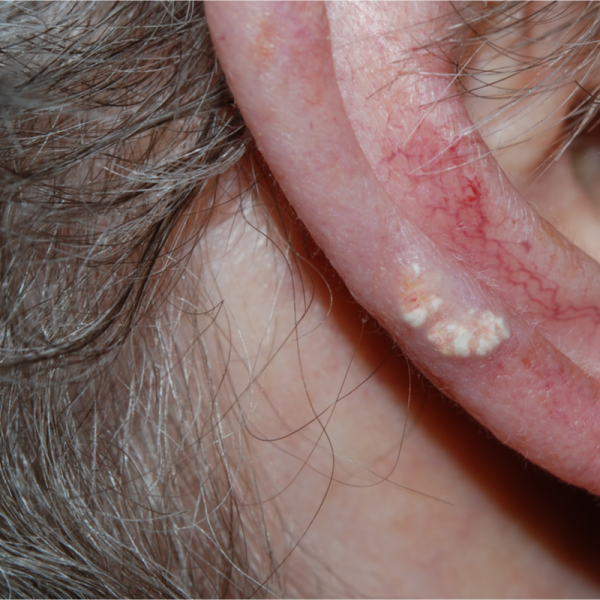
What is a malignant epithelioma?
An epithelioma, also called an epithelial cyst, is a malignant skin tumour that develops from the tissue layer of the skin or mucous membrane called the epithelium. Doctors distinguish between different types of epithelioma, which are classified according to their affected epithelial cells. Children in particular, but also all other age groups, can get an epithelioma. In adult patients, epithelioma occurs more frequently than average between 55 and 75 years of age, and men are more likely to develop the disease than women. Epithelioma is less common in dark-skinned people.
What are the symptoms of epithelioma?
Epitheliomas of the skin can manifest themselves externally through the following symptoms:
- recognisable, sinuous, reddened lines on the skin (a so-called skin mole),
- a newly formed or growing wart lesion,
- a hardened or ulcerated lesion,
- a painless swelling,
- a chronic scar that begins to bleed or changes in appearance.
If it is an epithelial tumour that has affected the organs, swelling may occur at the affected site or symptoms may develop that are related to the affected organ system.
How does a malignant epithelioma develop?
An epithelioma develops due to abnormal growth of the epithelium. The epithelium is the top layer of cells in human skin and mucous membrane tissue. The epithelium covers all surfaces of organs and other body structures and can lead to corresponding tumour formation if it degenerates.
What forms is an epithelioma divided into?
The most common epitheliomas are basal cell carcinomas and squamous cell carcinomas. These are two types of skin cancer, with basal cell carcinoma being the most common type of skin cancer among the epitheliomas. A basal cell carcinoma usually appears as a painless, raised area of skin and can take on a shiny appearance or have small blood vessels running through it. In most cases, basal cell carcinoma grows rather slowly and can cause tissue damage to the surrounding cells. The first choice of treatment for basal cell carcinoma is to surgically remove the tumour as completely as possible. In the case of a small basal cell carcinoma, this is usually possible with a simple excision (surgical intervention). For larger tumours, a so-called Mohs operation is performed. This is a special dermatosurgery procedure.
Squamous cell carcinoma, on the other hand, is also called epidermoid carcinoma and describes different types of cancer, each of which begins in the squamous cells. The squamous cells are found on the surface of the skin. However, they can also line hollow organs in the body, the respiratory tract or the digestive tract.
What can cause an epithelioma?
An epithelioma of the skin can be triggered by the following causes:
- a trauma,
- a chronic irritation,
- an HPV infection (human papilloma virus),
- prolonged exposure to the sun,
- frequent contact, possibly occupational, with tar and/or certain oils,
- Presence of benign skin conditions (so-called precancerous dermatoses), such as dermatitis, eczema, leukoplakia, psoriasis lesions, sebborhic keratosis, SLE skin lesions, warts, nevi (malformation of the skin or mucous membrane) or skin horns
How is an epithelioma diagnosed?
After a detailed medical history, the doctor will examine the patient physically. During this examination, the skin is mainly checked for swellings, hard, waxy nodules with a pearly edge and/or ulcers (so-called ulcerations) or indurations. When diagnosing an epithelioma, it is important to distinguish this disease from other similar diseases that also affect the skin mass. Since there are no specific laboratory findings associated with epitheliomas, other causes of skin lesions can be delineated by testing. These include, for example, allergies, syphilis or skin tuberculosis (lupus vulgaris). To make a definite diagnosis, any suspicious skin lesion should have a biopsy taken in addition to a test (if available).
How is an epithelioma treated?
Since the treatment of an epithelioma depends not only on the location, size as well as the stage of the tumour, but also on the age and general health of the patient, there is no standard treatment procedure for this disease. However, the following treatment methods belong to the standard measures for an epithelioma:
- complete surgical removal of the affected tissue, if possible,
- Radiation,
- Electrocautery, in which an electrocautery device (a small cautery iron with a fine wire loop) is used to generate electrical heat to cut or destroy the affected tissue,
- Combination therapy consisting of surgery plus electrocautery plus radiation,
- Combination therapy of surgery plus radiation: usually used for advanced tumours with metastases or infiltrations.
Cryosurgery can also be ordered. In this case, an attempt is made to specifically freeze the tumour cells or the superficial skin changes. External application of medicinal products such as podophyllin can at least alleviate the symptoms. If it is a recurrent basal cell epithelioma, chemosurgery can also be performed. This uses aggressive chemicals to destroy the affected tissue. The treatment procedure is also known as a cosmetic anti-ageing procedure or chemical peel. Chemosurgery is usually performed on the surface of the skin, although it can generally also be used internally, for example for the digestive tract and/or brain tissue.
What is the prognosis after a diagnosis of epithelioma?
The prognosis of an epithelioma depends entirely on the type of tumour, its location, extent and the stage of development at the time of diagnosis. However, most epitheliomas are usually very easy to treat, therefore have a good prognosis and rarely lead to death.
